STEAMcation Provides Summer STEAM ...With a Little Help from Illinois Friends
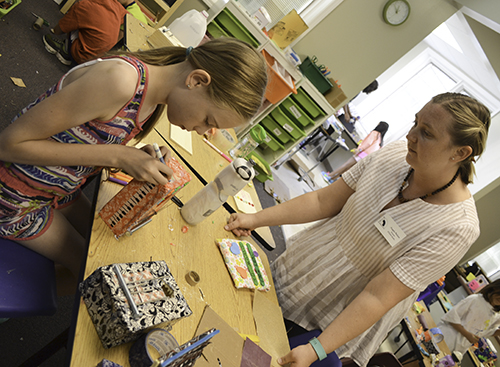
STEAM Studio Director Angela Nelson watches as a student puts the finishing touches on her muscial instrument during STEAMcation's STEAMtune week.
August 16, 2016
The 48 local youngsters who spent the summer at STEAMcation doing activities which incorporated art into a variety of STEM-related activities not only had a lot of fun. They learned some STEM principles too. And helping teach the youngsters about some of these topics were a number of outreach-minded University of Illinois folk, such as the MCBees, a graduate student group from MCB (Molecular and Cellular Biology), and RailTEC, the Rail Transportation and Engineering Center.
STEAMcation is the 9-week summer program of STEAM Studio, Next Generation School’s after-school and summer program that emphasizes STEAM (Science, Technology, Engineering, ART, and Mathematics). And according to Angela Nelson, STEAM Studio Director, the contributions by Illinois staff and students who helped teach lessons and conduct activities about their areas of expertise were invaluable. In fact, she can't overstate how important students’ exposure to all of these role models is. Says Nelson: “It’s huge; it’s huge!”
To ensure that the STEAMcation activities were age appropriate, the students were broken down into two groups (with appropriate, STEM-related names, of course): the group for younger students (1st and 2nd graders) was dubbed “Nano"; the group for older students (3rd–5th graders), was named “Tera.”
For each week of STEAMcation’s nine-week summer session, students addressed a different STEAM-related topic.
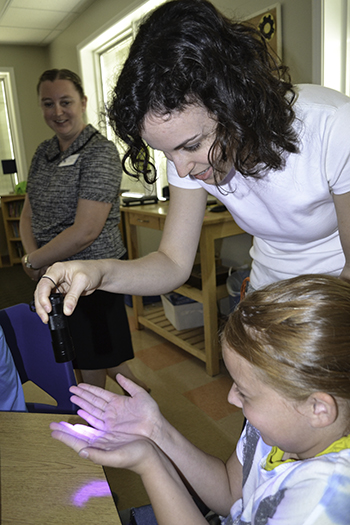
Angela Nelson (left) watches as Livezey (top right) shines a black light on a student's hands so she can see the "germs" during an activity.
- STEAMology (who are you as a fine arts specialist?).
- Sustainable Farming (students visited Illinois’ sustainable farm).
- Lights, Camera, Action! (more Hollywood and fine arts than STEM, students looked at how to make a colored shadow. They also wrote scripts that they got to perform at the end of the week.)
- Tinkering with Toys (students took toys apart, then learned how to make their own toys that could do different things).
- Oceanography (students made submarines that went down and came up via the use of syringes).
- Geocaching (students learned how to geocache).
- STEAMtune (students learned the science of how instruments work, then got to make their own).
- Castles and Courts (about science in medieval times; for this activity, the MCBees led a number of activities, including covering pennies with a zinc/copper alloy to turn them silver/gold).
- STEAMvention (trains and how they work, which included a visit to RailTEC).
In addition to exploring the nine weekly topics, each week, STEAMcation offered Makers Lab and Fine Arts Studio.
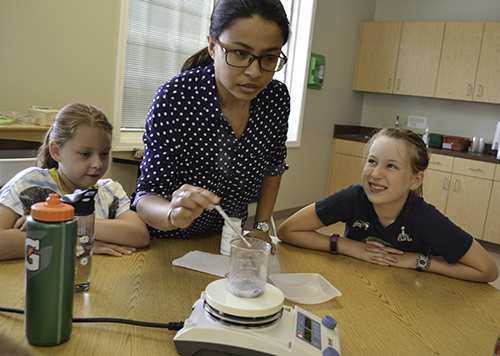
An MCB Ph.D student (center) works with some STEAMcation students to coat their pennies with a zinc/copper alloy.
“In the afternoon,” Nelson explains, “they got to have the fun, the running around, or testing their experiments ....They’ve been doing a lot of fun experiments where they get to really learn and have fun with the topics.” For instance, one activity involved making cardboard boats which they got to race in a pool.
Another of the summer's highlights? Interacting with Illinois faculty and students who shared their time and expertise with the youngsters.
For instance, for Castles and Courts week, on July 25th, several outreach-minded Ph.D. students who are members of the MCBees graduate student group from MCB (Molecular and Cellular Biology) took the morning away from their labs to visit STEAMcation to share about science in the medieval times with the youngsters. (See full story)
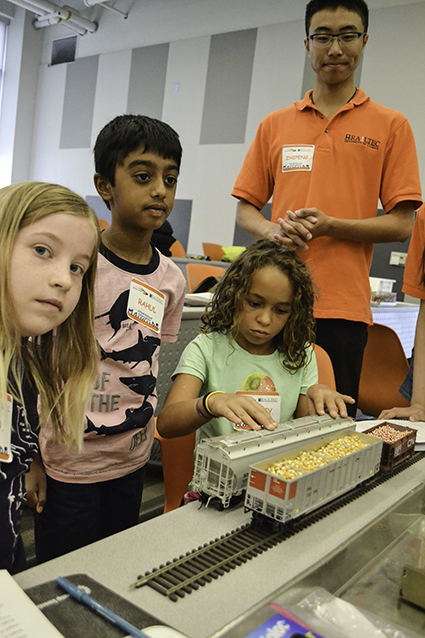
RailTEC grad student Zhipeng Zhang (right) supervizes as students learn about different sizes and types of railroad cars.
And on August 3, in an exciting end-of-the-summer field trip, STEAMcation's Tera group of 24 3rd–5th graders made a visit to Illinois’ RailTEC (Rail Transportation and Engineering Center) to learn all about trains as part of STEAMvention week.
According to Nelson, one benefit of activities like the MCBees and RailTEC visits was so students could experience STEAM in the real world.
“A big component of what we try to do at STEAM Studio is give them real-world experiences, so they realize that math and science is happening all over the place. And the key thing is that it’s not in isolation. So them going and seeing what these scientists are doing and seeing how they work together and how these experiments are done are helping to get them into a different frame of mind about what science is and the different facets of science so they can start to realize how they interconnect.”
She also hopes her students discover all the different ways that one can be a scientist. “So you don’t have to be a doctor or an engineer building a building. There’s lots of different ways that you can be a scientist,” says Nelson.
Nelson actually considers the lunch with the engineers during the RailTEC visit to be one of the highlights of the day: “Because they get to sit down with these people and ask them questions about how they got into what they do, and see how excited they are about their field and the cutting-edge research that’s happening, and get to ask those questions that are on their minds.”
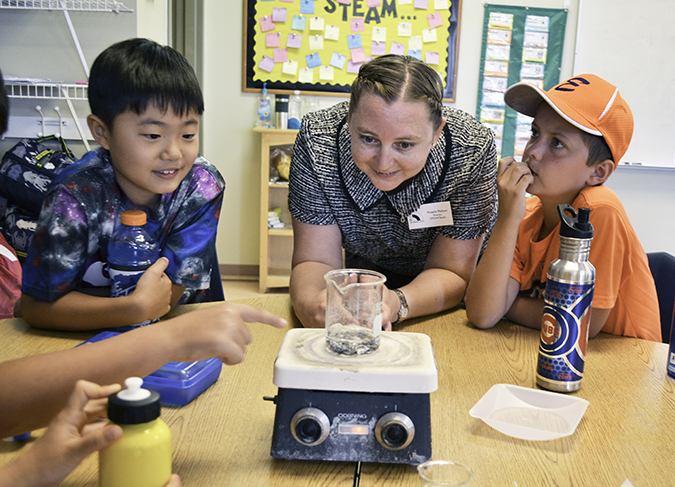
Angela Nelson (center) and some STEMcation students watch as their pennies are coated with a zinc/copper alloy.
Nelson also says that, as her program has grown over the last three years, she’s noticed that the types of questions her students are asking are a lot more deep.
“They’re actually starting to ask about the research when they talk to these people, and go, ‘Well, why did you do this?’ or ‘What did this mean?’ So it’s starting to break down the boundaries between scientists and the public in many ways. They’re thinking like a scientist. They’re asking the questions. They’re curious. And they’re starting to make connections between different fields.”

A STEMcation student makes his own musical instrument during STEAMtune week.
Nelson goes on to share the benefit to her students of being exposed to a varity of scientists and engineers in different fields. "There’s a stereotype out there," she adds, "that every scientist is sitting in a lab coat and just doing this type of experiment. But when they actually see that these people are doing lots of different types of experiments, and it’s impacting their own lives, then all of a sudden it has a lot more meaning to them. You don’t just have to be sitting at your desk the whole time to be a scientist."
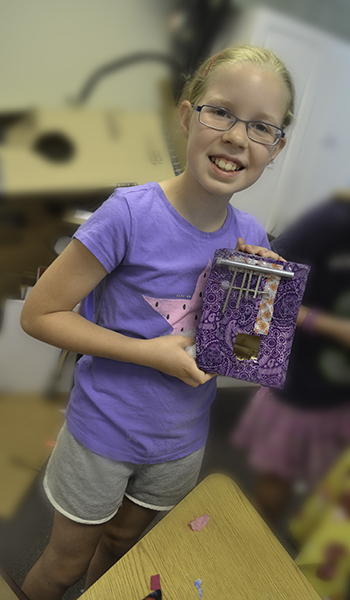
A STEMcation student shows off the musical instrument she built during STEAMtune week.
Nelson’s philosophy? Make everything a learning experience, even something that her young charges consider a mistake or failure.
“We really try to celebrate the unexpected. When things don’t work the way they are expected to, let’s not be upset with it or mad. But let’s start to question and understand what it means. The kids are doing that. They are spending more time trying to understand. So we’re opening their eyes and showing them that there’s no one right way. There’s multiple different ways."
Something else they push at STEAM Studio is discovery, inquiry-based learning. “We want them to discover, rather than be told,” admits Nelson. “And I’ve noticed that means so much more to them. And it’s amazing what a child can figure out on their own. So they make those connections on their own, and we just kind of give them the stepping blocks to get there.”
According to Nelson, it is the emphasis on hands-on activities that makes it so easy for the kids to learn.
“They love it!” she exclaims. “Sometimes they’re scared to start, but they’re excited about these topics and it’s possible to make it enriching for them. The key thing is that it’s hands on. We get scientists or community members to come in and do something with the kids. So it had some purpose to it other than just a presentation.”

A participant in STEAMcation is putting the finishing touches on her percussion instrument built during STEAMtune week.
Nelson particularly wants to express a thank-you to the University groups and personnel, like the MCBees and the RailTEC staff and students.
“I think the biggest thing is that we are so thankful for the amount of time that they are putting in to making this possible,” she says. “The number of students that they have coming in as well as professors and community members to support these kids and get them excited about this is huge... I know how much time it takes to come up with these activities and then to take the whole day and dedicate it to them. These types of collaborations make a big difference for the kids.
Nelson is also grateful to have a resource like the University nearby: It’s fortunate that we have UIUC so close. I’ve never run into a problem where I can’t find someone who doesn’t want to come and share and do something. It means so much to these kids.”
Story and photos by Elizabeth Innes, Communications Specialist, I-STEM Education Initiative.
More:
Graduate STEM Outreach,
K-6 Outreach , MCBees, Next Generation School, STEAM Studio, 2016
For more I-STEM articles about STEAM Studio ad Next Generation School, plesase see the following:
- STEAM STudio's STEAMcation Students Visit RailTEC...Learn All About Trains
- Illinois' MCBees Expose STEAM Studio's STEAMcation Students to Medieval Science
- Next Gen's STEAM Studio: An After-School STEM Program With a Dab of Creativity
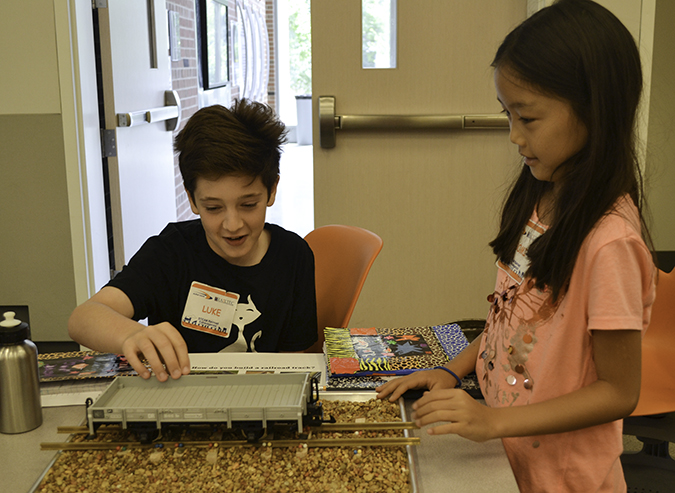
STEAMcation students move a railroad car back and forth on the railroad track they built during their visit to RailTEC.













.jpg)
















